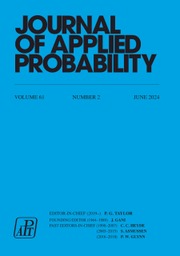Article contents
Coalescent theory for a Monoecious Random Mating Population with a Varying Size
Published online by Cambridge University Press: 14 July 2016
Abstract
Consider a monoecious diploid population with nonoverlapping generations, whose size varies with time according to an irreducible, aperiodic Markov chain with states x 1 N,…,x K N, where K ≪ N. It is assumed that all matings except for selfing are possible and equally probable. At time 0 a random sample of n ≪ N genes is taken. Given two successive population sizes x j N and x i N, the numbers of gametes that individual parents contribute to offspring can be shown to be exchangeable random variables distributed as G ij . Under minimal conditions on the first three moments of G ij for all i and j, a suitable effective population size N e is derived. Then if time is recorded in a backward direction in units of 2N e generations, it can be shown that coalescent theory holds.
Information
- Type
- Research Article
- Information
- Copyright
- Copyright © Applied Probability Trust 2010
References
- 3
- Cited by

